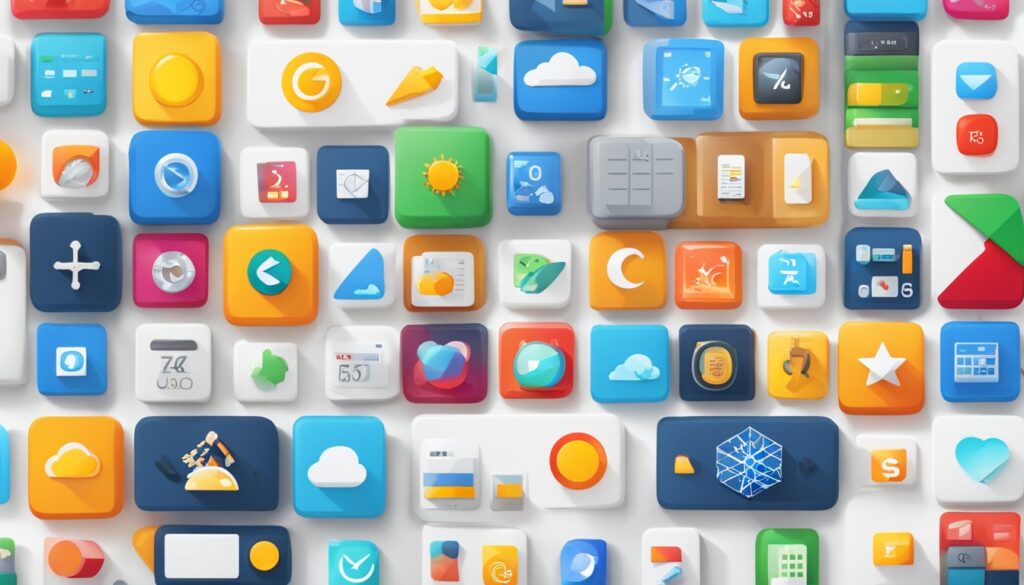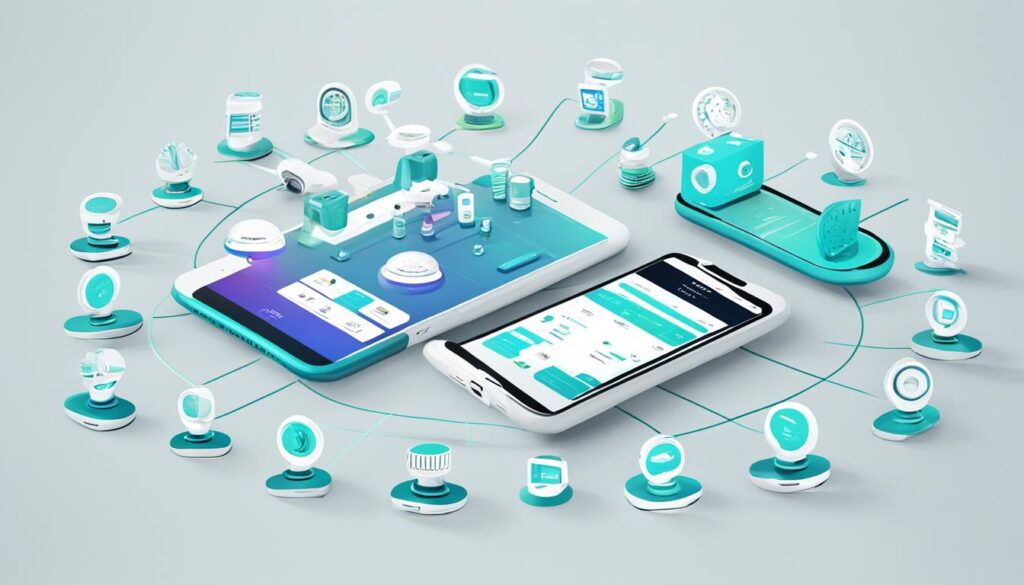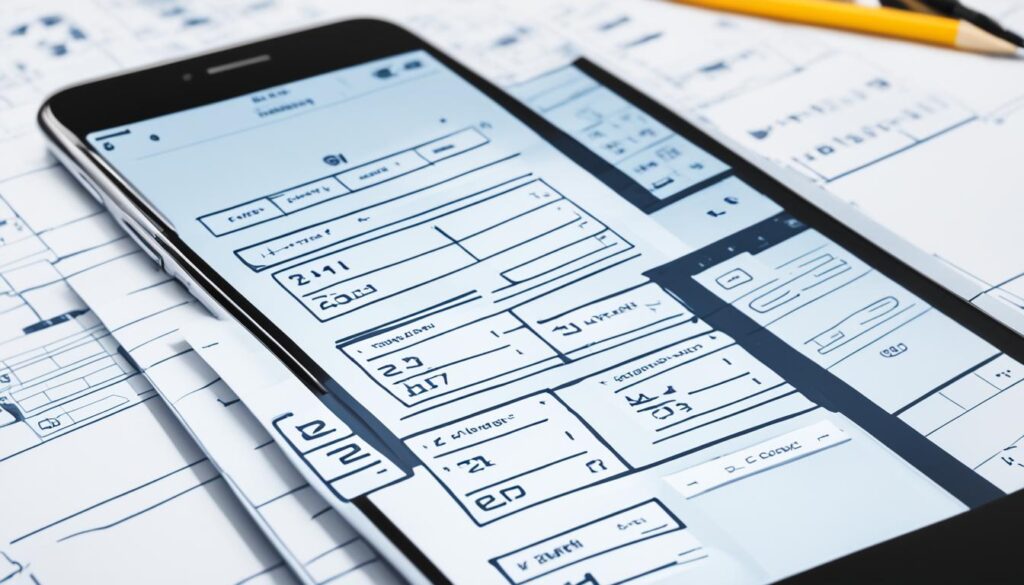In today’s fast-paced world, utility apps play a big role. They make everyday tasks easier and help users manage their lives better. This guide will show you how to make apps that really help people.
If you’re new or experienced in app development, this article has what you need. It covers everything from finding problems to solve to picking the right tools. You’ll get the steps to turn your app ideas into reality.
Table of Contents
Key Takeaways
- Understand the role and importance of utility apps in modern life
- Learn how to identify everyday problems that can be solved through app development
- Explore the key steps in the app creation process, from ideation to deployment
- Discover the best development tools and techniques for creating practical and user-friendly utility apps
- Learn how to enhance the user experience and drive user engagement with your app
What are Utility Apps?
In today’s digital world, utility apps are key for making daily tasks easier. They solve common problems people face every day. These apps make life more convenient and boost productivity.
Definition and Examples
Utility apps are apps that help you manage your time, find information, and automate tasks on your phone. Examples include apps for managing tasks, taking notes, checking the weather, converting units, and making mobile payments.
Role in Modern Life
With our lives getting busier and more tech-based, utility apps are now crucial. They help you stay organized, get important info, and do everyday tasks easily. This makes you more productive and improves your life quality.
| Utility App | Description | Key Benefits |
|---|---|---|
| Task Manager | Allows users to create, organize, and track their to-do lists and daily tasks. | Improves time management, increases productivity, and reduces stress. |
| Weather Forecaster | Provides up-to-date weather information, including forecasts, precipitation, and temperature. | Helps users plan their day and make informed decisions about activities and attire. |
| Mobile Payment | Enables users to make secure digital payments, often using their smartphones or smart devices. | Offers convenience, speed, and security for everyday transactions. |
The rise of utility apps shows how important they are in making our lives simpler. They play a big part in making everyday app use and app for daily tasks easier.
Identifying Everyday Problems to Solve
The first step in making a successful utility app is to find everyday problems that a mobile app can fix. This means doing market research, watching user behavior, and learning about the challenges and frustrations people deal with daily. By knowing what your users need and struggle with, you can make an app that helps them a lot, making their lives better.
To find everyday problems for a utility app, try these steps:
- Watch and study how your target users spend their days. What tasks or issues do they find hard?
- Talk to your potential customers through surveys, interviews, or focus groups. Ask them about the problems they face daily and what kind of app solutions they’d like.
- Look at online forums, social media, and customer reviews to see what pain points people often talk about.
- Check out industry trends and look at what other apps are missing to find unmet needs or areas where current apps don’t do well.
By identifying everyday problems and understanding user pain points, you can start thinking of app ideas. This way, you can make a utility app that really speaks to your audience and offers a useful, everyday app solution.
“The best apps are the ones that solve real problems in people’s lives.”
Developing Utility Apps for Everyday Use
Ideation and Planning
After spotting the problem you aim to solve, start the ideation and planning phase in the app development process. This phase is for thinking about what features and functions your app will have. Make sure it meets the needs of your target audience.
In the utility app ideation stage, focus on the user’s challenges. Think about how your app can make their daily tasks easier or better their life. List features that would make the app a must-have. Then, pick the most important ones that will offer the most value to users.
Next, in the app planning phase, create a detailed plan for development. Include milestones, timelines, and how you’ll use resources. Think about the user experience (UX) and design. Make sure the app is easy to use and looks good.
Designing User Experience
At the core of user-centric design is knowing your target users well. Do market research, talk to users, and look at what others in the market are doing. This helps you understand what your audience likes and needs.
Use what you learn to shape the app UX design. Make sure the app’s layout, how you move through it, and the overall flow are smooth and easy to follow. Keep it simple and easy to use. Utility apps should offer quick benefits without being too complicated.
Do iterative prototyping and usability testing to improve the design. Get feedback from real users and use their ideas to make the app better. This way, you create a top-notch user experience.
Choosing the Right Development Tools
Creating a successful utility app means picking the right tools. This means choosing the best programming languages and using frameworks and libraries that make development easier and improve the app’s features.
Programming Languages
The programming language you pick affects your app’s efficiency, growth, and ease of upkeep. Here are some top choices:
- Java – A versatile language used for Android apps, known for its strength and ability to work on different platforms.
- Swift – Apple’s official language for iOS, macOS, and other Apple platforms, offering a modern and clear syntax.
- Kotlin – A language gaining popularity in Android development, known for making code easier to read and write.
Frameworks and Libraries
Using strong frameworks and libraries can speed up your app’s development. They offer pre-built functions and best practices. Here are some top picks:
- React Native – A framework that lets you make mobile apps with JavaScript and React, making it easier to reuse code and work faster.
- Flutter – Google’s toolkit for making apps for mobile, web, and desktop from one codebase.
- Android Studio – The official IDE for Android app development, offering many tools and libraries to make development smoother.
By looking at the available app development tools, programming languages, app frameworks, and app libraries, you can make sure your utility app has a strong base for success.
Building the Core Functionality
After planning and designing, it’s time to build the core of a utility app. This means making the key features and abilities that solve user problems. It’s vital to start with a Minimum Viable Product (MVP) to test and improve it, then add more features later.
The main goal in this phase of the app development process is to focus on the app’s core features and functionality. Developers should make sure the MVP is engaging and meets the needs of the users. This might include features like:
- Streamlined user interface for easy navigation and task completion
- Seamless integration with relevant data sources or external services
- Intuitive app prototyping and user interactions
- Efficient data processing and storage mechanisms
- Robust error handling and feedback mechanisms
By focusing on the app’s core, developers lay a strong foundation for the MVP. This makes the app development process more focused. It allows for gathering user feedback and improving the app over time.
“The key to building a successful utility app is to focus on creating a Minimum Viable Product that solves a specific user problem extremely well, and then continuously improve and expand the app’s functionality based on feedback.”
This method helps developers make apps that meet user needs and can grow and change over time. It ensures the app stays relevant and keeps users engaged.
Enhancing User Experience
Making a utility app easy and fun to use is key to its success. This means creating a design that looks good and is easy to get around in. It also means testing the app to find and fix any tricky parts. By listening to what users say and making changes, you can make sure your app is a joy to use.
User Interface Design
Your app’s UI should look good, be easy to use, and be simple to navigate. This means having a clean layout, clear labels, and smart use of colors and images. By focusing on making the app user-friendly, you can make it both pretty and useful.
Usability Testing
Testing your app regularly is vital to find and fix any tough spots. You can do this by getting feedback from different users, watching how they use the app, and making changes based on what you learn. By always improving the app based on what users say, you can keep it useful and important to your audience.
“Usability is a key factor in the success of any utility app. By prioritizing user experience and continuously iterating based on feedback, you can create an app that truly meets the needs of your target audience.”
Integrating with Other Apps and Services
To make your utility app better, it’s key to work well with other apps and services. Using API integration, you can use the data and features of other apps. This lets your app share info and make tasks easier for users.
Creating an app ecosystem by working with third-party services makes your app better. It turns your app into a central place for users to find many tools and features. They won’t need to jump between different apps.
| Benefit | Description |
|---|---|
| Enhanced Functionality | Work with other apps and services to make your utility app more powerful. Users get a better and more varied experience. |
| Improved Efficiency | Make workflows smoother and cut down on the need to move data or switch apps. This boosts productivity. |
| Increased Engagement | Working well with popular platforms makes your app more appealing and necessary for users. This builds loyalty and more use. |
By using app integration and building a strong app ecosystem, you can turn your utility app into a key part of users’ daily lives.
“The key to building a successful utility app is to make it an integral part of your users’ daily routines by seamlessly integrating it with the services and platforms they already rely on.”
Monetization Strategies
Creating a strong app monetization plan is key for your app’s success. You can use different ways to make money, like in-app ads, paid upgrades, or a freemium model. This means offering a free basic version with extra paid features. Think about what your users like to find the best way to make money without annoying them.
Advertising
Using in-app ads is a good way to make money from your app. This lets advertisers pay you while still giving users a free or cheaper app. If done right, ads can make the app better without getting in the way of what it does.
Paid Upgrades
Offering paid upgrades or extra features can help too. Users can pay to get more out of your app or to get rid of ads. This way, you make money and still offer a basic app for free. It lets users pick what they want to pay for.
“Finding the right balance between generating revenue and maintaining a positive user experience is key to successful app monetization.”
The secret to making money from your app is to know your audience well. By offering choices from free to paid, you meet different users’ needs and keep your app going strong.
App Store Submission and Marketing
Getting your utility app ready for launch means understanding the app store submission process and marketing. It’s key to stand out in the crowded mobile app world. Knowing the app store guidelines and using smart marketing can help increase your app’s visibility and attract users.
App Store Guidelines
First, learn the app store’s rules. These cover everything from app content to technical details and privacy policies. Following these guidelines is crucial for approval and ensures a good user experience.
Marketing Tactics
After preparing your app, create a strong marketing plan. This plan should include:
- App Store Optimization (ASO): Make your app’s listing better by optimizing its title, description, keywords, and visuals. This helps people find your app more easily.
- Social Media Campaigns: Use social media to promote your app and connect with your audience. This helps build a loyal group of users.
- Influencer Partnerships: Work with influencers or experts to reach more people and make your app more credible.
- Content Marketing: Create useful content like blog posts or videos to teach and draw in potential users.
By using app store optimization and targeted marketing, you can make your utility app more successful in the competitive app market.
| Marketing Tactic | Description | Benefits |
|---|---|---|
| App Store Optimization (ASO) | Optimizing your app’s listing to make it easier to find and rank higher in app store searches. | More visibility, better conversion rates, and more organic downloads. |
| Social Media Campaigns | Using social media to promote your app and engage with your audience to build loyalty. | Wider reach, better brand awareness, and stronger user interaction. |
| Influencer Partnerships | Working with influencers to reach more people and increase trust in your app. | More trust, improved reputation, and better user acquisition. |
| Content Marketing | Creating content to educate and attract potential users. | Better thought leadership, stronger customer ties, and more website traffic. |
Continuous Improvement and Updates
Creating a successful utility app is an ongoing task, not just a one-time job. To keep your app relevant and useful over time, it’s key to always listen to what users say. This means making updates and changes regularly to keep up with the fast-paced world of mobile apps.
Listening to your app’s users gives you important insights. You learn how they use your app, what they like, and where they struggle. This info helps you make your app better by focusing on the most important changes.
Updating your app often helps fix bugs and add new features. These updates can make your app more useful and fun for users. They show you care about making your app the best it can be.
Managing your app’s life cycle means having a plan for getting and using user feedback. This might mean using feedback tools in your app, reading online reviews, and talking with your users. This helps you understand what they need and want.
By always working to improve and update your app, you make sure it stays a key part of your users’ lives. This keeps you ahead in the competitive app market.
| Key Considerations for Continuous App Improvement | Strategies for Successful App Updates |
|---|---|
|
|
“Constant iteration and updates are the keys to maintaining a successful utility app in today’s competitive mobile landscape.”
Security and Privacy Considerations
When making utility apps, it’s key to focus on app security and user data privacy. Doing this builds trust with your users. It also ensures their personal info is safe and you follow the law.
To keep your app and user data safe, think about these steps:
- Use data encryption to keep user info safe.
- Follow data privacy laws, like GDPR and CCPA, to show you care about data protection.
- Have clear privacy policies that explain how you handle data.
- Keep checking and updating your security steps to stay ahead of threats and follow the law.
With these steps, you’ll make your users feel secure. This helps your utility app do well over time.
| Security Measure | Description |
|---|---|
| Data Encryption | Use top-notch encryption to keep user data safe and protect sensitive info. |
| Privacy Policies | Make detailed privacy policies that explain how you handle data and follow the rules. |
| Regulatory Compliance | Make sure your app follows data privacy laws, like GDPR and CCPA, to show you value user data privacy. |
“Building trust with users should be a top priority when developing utility apps. Robust security and privacy measures are the foundation for this trust.”
Developing Utility Apps for Everyday Use
Making apps that make daily tasks easier is a great way to improve people’s lives. This guide will show you how to make apps that solve real problems. You’ll learn about finding user needs, designing easy-to-use interfaces, and making money from your app.
Creating utility app development means knowing what your users need. You must research the market and listen to what users say. This helps you make practical app creation that solves everyday problems.
It’s also important to think about how easy your app is to use. A good design makes users happy and helps your app succeed. This is key for utility app development.
For your app to last, you need to make money in ways that users like. This could be through ads, subscriptions, or other methods. These should add value to your app and help it keep going.
“The true value of a utility app lies in its ability to simplify and streamline everyday tasks, ultimately enhancing the quality of life for its users.”
This guide will help you make the most of utility app development. You can create apps that really help people. Start making everyday app solutions that stand out in the app world.
Conclusion
Creating utility apps for everyday use is both rewarding and valuable. These apps play a big role in our lives today. They solve problems and make our daily tasks easier.
By understanding their importance and following a clear development process, you can make apps that truly help people. The need for efficiency and convenience is growing. This makes the utility app market a great chance for developers and entrepreneurs to make a difference.
The utility app development summary shows how these apps make our lives simpler. The process of making these apps involves careful planning and using the right tools. By doing well in the app development journey, you can succeed and help grow the mobile app world.
The future of app development looks bright, with more people needing utility apps. If you have the right skills and dedication, you can make apps that fit into people’s daily lives. These apps will offer the convenience and efficiency we all want in our digital world.














